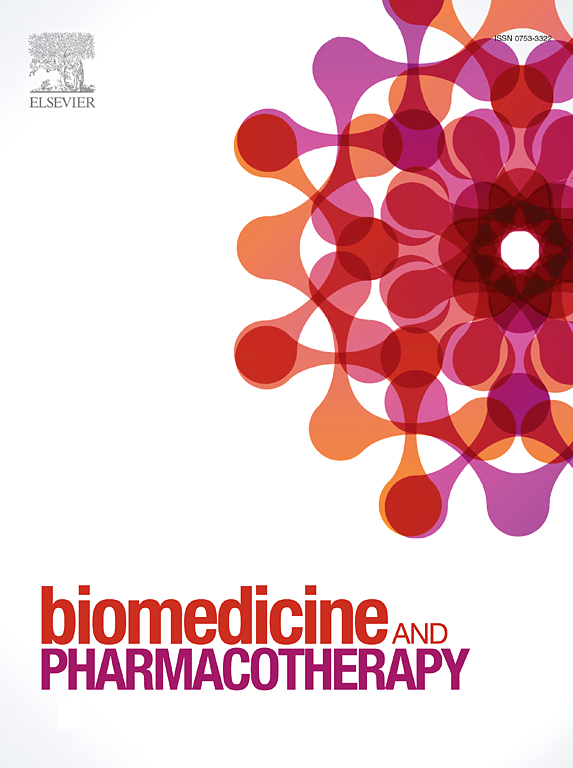ericitrin及其衍生物抗阿尔茨海默病:体外和体内研究的累积记录
IF 6.9
2区 医学
Q1 MEDICINE, RESEARCH & EXPERIMENTAL
引用次数: 0
摘要
阿尔茨海默病(AD)是最常见的神经退行性疾病(ND),其危害不仅限于大脑。由于与其他ndds的复杂和相互关联的病理,对多维ad相关逆境的有效治疗尚未报道。一些植物成分已被报道,目前正在研究其在AD中的生物活性潜力。Eriocitrin是一种二氢类黄酮化合物,存在于柑橘类水果,如柠檬、酸橙、柠檬皮、葡萄柚和蔬菜,以及饮料和葡萄酒等加工产品中,连同其衍生物橙皮苷、橙皮苷、eriodictyol和homoeriodictyol,据报道在几种体外和体内模型中具有多种神经保护生物活性,包括抗炎、抗氧化、抗淀粉样变性、抗tau磷酸化和抗凋亡特性。然而,目前还没有一篇全面的综述综述并将其衍生物对AD的多维生物活性潜能进行综合分析。本文从体外和体内两方面深入探讨了苦玉米皮苷及其衍生物在改善AD相关信号通路中的作用,并总结了苦玉米皮苷与不同植物类黄酮类化合物在长期饮食实践中对抗AD和其他类似NDs的作用。此外,本综述建议研究各种纳米配方的芥子皮精及其衍生物的抗ad作用,并与母体化合物进行比较。此外,还需要进行深入的体外和体内研究,以及不同的临床试验,以充分阐明埃立霉素及其衍生物在阿尔茨海默病病理中的真正潜力。本文章由计算机程序翻译,如有差异,请以英文原文为准。
Eriocitrin and its derivatives against Alzheimer’s disease: Cumulative accounts of in vitro and in vivo studies
Alzheimer’s disease (AD) is the most prevalent neurodegenerative disease (ND), and its adversities are not limited to the brain. Due to complex and interconnected pathologies with other NDs, an effective treatment for multidimensional AD-related adversities has yet to be reported. Several phytoconstituents have been reported and are currently being studied for their bioactive potential in AD. Eriocitrin, a dihydroflavonoid compound present in citrus fruits, such as lemons, limes, lemon peels, grapefruit, and vegetables, and processed items, such as beverages and wine, along with its derivatives hesperetin, hesperidin, eriodictyol, and homoeriodictyol, has been reported to possess various neuroprotective bioactivities, including anti-inflammatory, anti-oxidative, anti-amyloidogenic, anti-tau phosphorylation, and anti-apoptotic properties, in several in vitro and in vivo models. However, a comprehensive review summarizing and correlating the multidimensional bioactive potentials of eriocitrin and its derivatives against AD has yet to be compiled. This review extensively discusses the in-depth role of eriocitrin and its derivatives in ameliorating different AD-related signaling pathways both in vitro and in vivo, and summarizes the incorporation of eriocitrin like different plant-based flavonoids in long-term dietary practice to combat AD and other similar NDs. Additionally, this review suggests examining various nano-formulations of eriocitrin and its derivatives for their anti-AD effects in comparison to the parent compound. Furthermore, in-depth in vitro and in vivo studies, along with different clinical trials, should be conducted to fully elucidate the true potential of eriocitrin and its derivatives in AD pathology.
求助全文
通过发布文献求助,成功后即可免费获取论文全文。
去求助
来源期刊
CiteScore
11.90
自引率
2.70%
发文量
1621
审稿时长
48 days
期刊介绍:
Biomedicine & Pharmacotherapy stands as a multidisciplinary journal, presenting a spectrum of original research reports, reviews, and communications in the realms of clinical and basic medicine, as well as pharmacology. The journal spans various fields, including Cancer, Nutriceutics, Neurodegenerative, Cardiac, and Infectious Diseases.

 求助内容:
求助内容: 应助结果提醒方式:
应助结果提醒方式:


